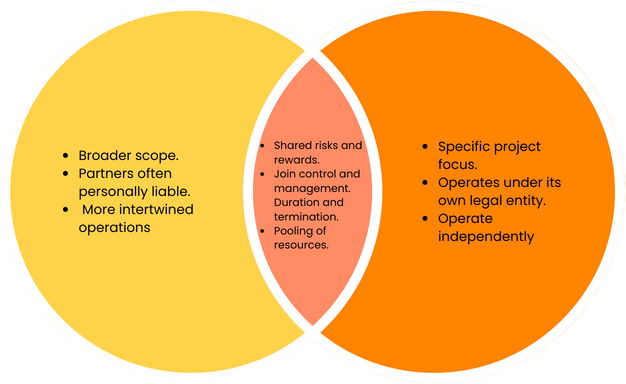How is a partnership similar to a joint venture?
Category partnerships

Posted by Wei T.
Growth Marketing Expert

In essence, both partnerships and joint ventures are collaborative business structures where entities come together for mutual benefit. They share common features such as the pooling of resources, joint control and management, and the distribution of risks and rewards. While they have their unique characteristics, their foundational similarity lies in leveraging combined strengths for a shared objective.
In today's fast-paced and interconnected business landscape, collaboration has become more than a mere buzzword; it's a necessity. Companies, whether large or small, often look for ways to merge strengths, combine resources, and tap into shared audiences.
It's no wonder that models like partnerships and joint ventures have become such popular routes to achieve growth and success. But how are these two concepts interlinked? What common ground exists between a traditional partnership and a joint venture?
Let's embark on an exploration of these two collaborative business structures, diving deep into their shared features and distinctions.
Defining the Concepts
Partnership
What is a business partnership?
A business partnership is a legal relationship formed by the agreement between two or more individuals or entities to carry on a business as co-owners.
Partnerships blend skills, resources, and expertise, often leading to greater business potential than solo ventures.
Think of it as a symbiotic relationship where each party offers something valuable for the mutual benefit of the partnership.
Types of partnerships and their unique characteristics:
| Type of Partnership | Characteristics |
|---|---|
| General Partnership |
|
| Limited Partnership |
|
| Limited Liability Partnership (LLP) |
|
For a more comprehensive dive into partnerships and their power, head over to Business Partnerships: The Power of Collaboration.
Joint Venture
Definition and explanation:
A joint venture (JV) is a business arrangement where two or more parties agree to pool their resources and expertise for the purpose of accomplishing a specific task or business activity. Unlike a partnership that may have an indefinite lifespan, a JV typically focuses on a single project or business activity, and it often has a set duration.
Situations where a joint venture is typically used:
- Project-Based Collaboration: When companies join forces for a particular project, like constructing a building or launching a new product line.
- Market Entry: Often used by companies looking to enter new markets, especially international ones. Partnering with a local company can ease this transition.
- Sharing of Resources: When businesses want to share resources, such as technology or intellectual property, without a full merger or acquisition.
- Risk Sharing: Companies might enter a JV to share the risks associated with a new business venture.
For budding entrepreneurs and seasoned business professionals alike, understanding the intricacies of online partnership marketing can make the difference between a thriving collaboration and a missed opportunity.
Similarities Between Partnership and Joint Venture

Here's a Venn diagram showcasing the similarities and differences between partnerships and joint ventures. The overlapping section highlights the shared characteristics, while the individual sections list unique features of each business model.
Shared Risks and Rewards
Both partnerships and joint ventures operate on a foundation of shared risks and rewards. It means that all involved entities have stakes in both the potential upsides and the possible pitfalls of the collaboration. When profits roll in, they are shared among the partners or joint venture entities based on pre-agreed terms.
Similarly, if there's a loss, the burden is distributed among the parties involved. This mutual involvement ensures that all participants remain deeply vested in the success of the endeavor. Learn more about the intricacies of such collaborations from Business Partnerships: The Power of Collaboration.
Joint Control and Management
In both partnerships and joint ventures, there's a joint control mechanism. While the specifics can vary based on the terms set during the formation, participants in both structures have a say in the decision-making processes.
This cooperative approach ensures that no single entity can unilaterally dictate the course of the collaboration.
Duration and Termination
Partnerships and joint ventures might have different life spans, but they share commonalities in terms of duration and termination. Both can be set for a specified period or revolve around a particular project's completion.
However, the key distinction is that while partnerships might often have a more open-ended duration, joint ventures are typically more finite.
Yet, understanding how to structure and when to terminate these collaborations is crucial. Dive deeper into the dynamics from How to Create Partnerships.
Pooling of Resources
Pooling resources is a hallmark of both partnerships and joint ventures. Whether it's financial resources, human expertise, technology, or intellectual property, collaborating entities bring their strengths to the table.
By doing so, they often create a synergy that allows for more significant accomplishments than if they operated in isolation.
Such shared endeavors, especially in the digital age, can significantly benefit from insights found in Online Partnership Marketing.
Key Differences
Purpose and Scope
While partnerships often form with a broader scope and an ongoing nature in mind, joint ventures are more narrowly focused.
A joint venture revolves around a specific project or business activity, while a partnership is generally more holistic, covering a range of business operations.
Legal Structure and Liability
Partnerships and joint ventures differ notably in their legal recognition and associated liabilities.
In a partnership, partners are often personally liable for the business's debts and actions, unless it's an LLP (Limited Liability Partnership).
On the other hand, a joint venture might operate under its own separate legal entity, shielding the parent companies from direct liabilities.
Independence
The nature of a joint venture often allows it to stand alone, separate from the parent entities. It means that while they might share resources and expertise, the JV itself operates independently.
Partnerships, by contrast, are more intertwined. Partners remain integrally linked in their operations, management, and financial matters.

Here's a flowchart outlining the steps a business might take when deciding to establish either a partnership or a joint venture. It starts with identifying business goals, evaluating the need for collaboration, deciding on the type of collaboration, defining terms and conditions, and finally, establishing the collaboration.
Benefits of Choosing Either Model
Whether you lean towards establishing a partnership or embarking on a joint venture, both collaborative models offer a myriad of benefits, some of which include:
Efficient Resource Allocation
Both partnerships and joint ventures excel at maximizing the use of available resources. Combining the strengths of multiple entities ensures that skills, finances, technology, and other critical resources are utilized optimally.
This pooling not only leads to cost savings but can also drive a more effective and streamlined operation. Explore the Cost-efficient Methods for Promoting Online Store for insights into leveraging resources in the digital marketplace.
Enhanced Market Presence
Joining forces under either model can significantly amplify a business's market presence.
The power of combined branding, reputation, and reach means that the collaborative entity can often achieve a broader audience engagement and recognition than if the parties operated separately.
Innovation and Knowledge Sharing
When different businesses come together, they bring along unique perspectives, experiences, and expertise.
This pooling of knowledge can lead to innovative solutions, new product ideas, and more efficient operational strategies. For instance, strategies like Automated Cross-selling can be enhanced with combined insights, leading to significant boosts in sales.
Conclusion
The business landscape is evolving rapidly, and with it, the strategies companies employ to navigate their growth trajectories.
Understanding the nuances between partnerships and joint ventures is not just academic; it's foundational for any business considering collaborative growth.
Embracing the power of synergy, mutual growth, and collective expertise that these models offer can be a game-changer in our interconnected business world.
Intrigued by the world of business collaborations? Eager to leverage the power of combined expertise? Dive deeper with CrossyShop! Explore our treasure trove of resources, insights, and guides that will empower you to craft effective partnership strategies and elevate your business collaborations to the next level.